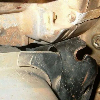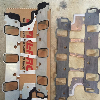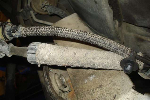Alex8706
Member
- Joined
- January 17, 2018
- Messages
- 46
- Reaction score
- 3
- City, State
- Portland, OR
- Year, Model & Trim Level
- 1992 Explorer Sport
92 explorer sport 4x4 5 speed manual with manual locking hubs.
Ive been having some squeaking going on at pretty much all speeds for a few weeks now but havent done anything about it. But this morning i started to get some vibrations while slowing down starting at about 35-40 mph. The closer i come to a stop the more extreme the vibration is and i still get the vibration when i coast to a stop too just not as extreme. Brake pedal doesnt vibrate at all. Steering wheel doesnt seem to move. Thought it might be a warped rotor, and maybe it is, but i thought those were two signs of that. I dont know a lot about suspension but i did get under it to check to see if anything was loose but it all felt good.
I did replace the rear drum brakes and hardware about two months ago. Havent done anything to the front. Recently learned that i can go forward and reverse and sharply brake to adjust the back brakes better and i did that about a week ago. I am confident i put all the hardware on properly. Not sure if that can be a casue or not but figured it might be worth mentioning.
Not sure what it could be. If i could get any ideas that would be great. Thank you.
Ive been having some squeaking going on at pretty much all speeds for a few weeks now but havent done anything about it. But this morning i started to get some vibrations while slowing down starting at about 35-40 mph. The closer i come to a stop the more extreme the vibration is and i still get the vibration when i coast to a stop too just not as extreme. Brake pedal doesnt vibrate at all. Steering wheel doesnt seem to move. Thought it might be a warped rotor, and maybe it is, but i thought those were two signs of that. I dont know a lot about suspension but i did get under it to check to see if anything was loose but it all felt good.
I did replace the rear drum brakes and hardware about two months ago. Havent done anything to the front. Recently learned that i can go forward and reverse and sharply brake to adjust the back brakes better and i did that about a week ago. I am confident i put all the hardware on properly. Not sure if that can be a casue or not but figured it might be worth mentioning.
Not sure what it could be. If i could get any ideas that would be great. Thank you.










